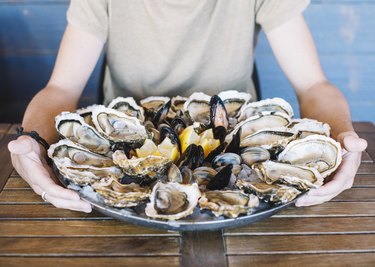
Broadly speaking, clams and oysters share a definition as bivalves – an edible aquatic mollusk with a soft body enclosed within a two-sided, hard-hinged shell of equal size. Even without tasting, an observer will notice a key distinction in clam vs. oyster appearance — that is, the smooth shell of a clam as opposed to the oyster's tough, irregular shell. Both clams and oysters are commonly served fresh in many coastal communities, with the oyster being the more highly prized as a delicacy.
What Is a Bivalve?
Video of the Day
In addition to clams and oysters, both with grayish-colored shells, other bivalves include scallops and mussels. There are about 15,000 different species within the animal group that shares the mollusk category with gastropods (snails and slugs) and cephalopods (octopus and squid).
Video of the Day
Univalves are sea creatures such as abalone, conch and whelk that have a single shell covering a soft body. Crabs, crayfish, lobster and shrimp are crustaceans, another type of shellfish covered with a sectioned thick or thin shell.
Where Do Clams and Oysters Come From?
Clams are commonly found in salt marshes and mudflats up and down North America's Atlantic coast. Some clam species are found along the Pacific coast, and others can be found in fresh water.
Oysters are found in salt water growing in clusters known as an oyster bed or an oyster reef, where they cling to a submerged pier, rock piles or other hard surfaces. In addition to oyster farms in North America, oysters are cultivated in far-flung locations around the world, from France to Japan to New Zealand.
Do Clams Taste Like Oysters?
Clam vs. oyster is a long-standing conversation, as the relationship between clams and oysters is closer than that of other types of mollusks. However, the taste profiles differ. A clam is meaty and chewy, while the o_yster's texture is smooth and the taste more briny_.
Famous Clam and Oyster Dishes
A raw clam on the halfshell is slightly salty, faintly sweet and slightly fishy. Clams taste quite different when served steamed, fried in a batter coating or added to a creamy New England chowder recipe or a Manhattan-style, tomato-based soup.
At Tadich Grill in San Francisco, California's oldest restaurant, the signature cioppino dish features clams in a tomato sauce accompanied by mussels, crab, shrimp and white fish. Ceviche, featuring raw oysters (and other seafood) cured in citrus juices, is a Peruvian dish that has gained popularity in North America.
Oysters can be fried, steamed, roasted or added to a fish stew. At Boston's historic Union Oyster House, one of America's oldest restaurants, oyster clam chowder is a specialty. When baked and topped with a buttery sauce and seasoned with parsley and bread crumbs, a tasty dish known as oysters Rockefeller is associated with New Orleans. Oyster lovers prefer eating them raw and slightly chilled on a bed of ice soon after they've been shucked.
Nutrition in Clams vs. Oysters
Low in fat, shellfish provide an excellent source of protein and essential minerals such as zinc, iron and magnesium, so they are a good alternative to meat. A clam provides nearly three times the protein of an equivalent-sized oyster: approximately 25.5 grams of protein per 100 grams or about 10 small, steamed clams.
The same size serving of oysters provides approximately 9 grams of protein as well as vitamins, minerals and omega-3 fatty acids.
Do Clams or Oysters Have Pearls?
Oysters are the pearl producers, although it's exceedingly rare to find a natural pearl. A pearl can form when an irritant such as a grain of sand embeds itself within the oyster, which forms a crystalline substance called nacre to surround it. Cultured pearls, also valuable but not so rare, are produced when an irritant is intentionally inserted to begin the process. Clams cannot produce pearls.